Learn how to make easy gluten-free pizza crust with this homemade recipe perfect for beginners! Not only does the dough bake up golden and fluffy, but it requires no kneading and only one rise. Learn my easy trick for mimicking stretchy dough texture, just as good as legendary pizzerias!
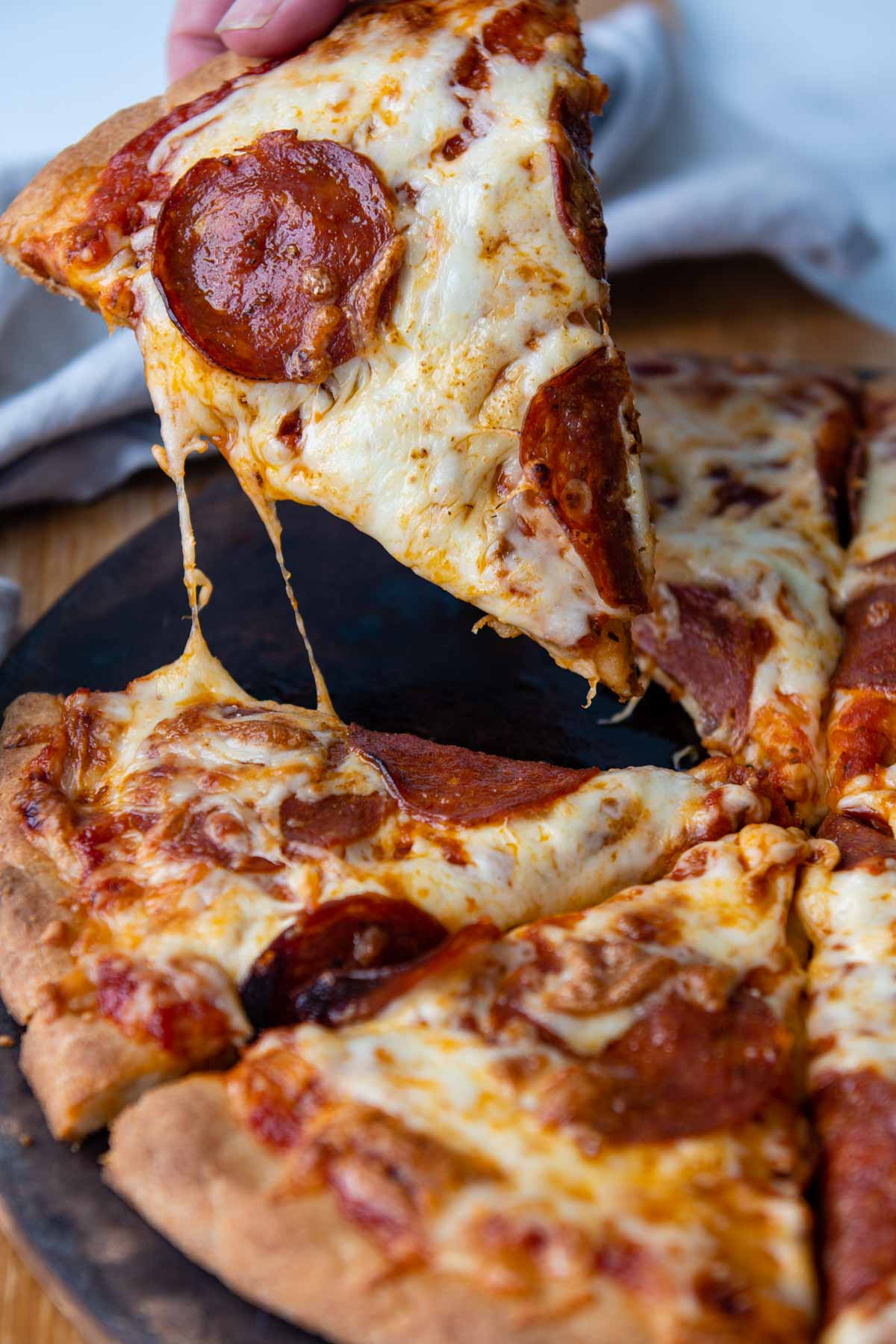
Easy Gluten-Free Pizza Crust
No longer does making a homemade gluten-free pizza crust recipe have to be laborious, frustrating, or lead to disappointing results. This GF crust makes the base of your dreams to load with whatever your heart desires!
Pizza dough with gluten-free flour starts with a simple list of ingredients. Although it requires some time for rising and baking, it’s easy, effortless and those just learning how to navigate a gluten-free diet.
So, what is the trick? Why will this recipe help you banish cardboard crusts forever? Although the crust relies primarily on gluten-free flour to build structure, through testing, I discovered swapping some of it out with another GF starch aids a light and fluffy texture, instead of dense and chewy.
In the case of gluten-free pepperoni rolls, a small amount of potato starch does the trick. But for gluten-free pizza crust, I needed something that would also add moisture and cut chewiness, since the recipe contains no eggs or butter.
Using a small amount of almond flour does the trick! You’ll still be enjoying not only a gluten-free, but dairy-free and vegan pizza, but once baked, it mimics a soft, fluffy crust just as good as you remember!
Below I teach you not only how to make pizza crust with gluten-free flour, but many other gluten-free baking tips, such as the best GF flour to use, make-ahead instructions, ingredient swaps, as well as recommended kitchen tools to make your life easier!
If you want to recreate the entire pizzeria experience, don’t forget to try these other highly-reviewed recipes for gluten-free garlic knots or soft gluten-free breadsticks!
Ingredient notes
Below are the recommended ingredients, along with the reason I use them and any workable substitutions. Please note, that while using a small amount of almond flour yields the best results, if you don’t have it on hand, additional GF flour or homemade oat flour may be used.
- Gluten-Free Flour Blend – Use a quality all purpose gluten-free flour with xanthan gum included, such as Cup4Cup. For more suggested GF flours, refer to the recommended gluten-free flour section.
- Almond Flour – For best results adding a small amount reduces chewiness and enhances flavor. Alternatively, replace with additional GF flour or oat flour.
- Psyllium Husk Powder – Greatly enhances structure, elasticity, and stretchy texture. Learn more about why psyllium husk in gluten-free baking improves results drastically!
- Baking Powder – Since gluten-free dough needs a little assistance with rising, I prefer to use a combination of baking powder with yeast. This helps with lift and an airy texture.
- Instant Rise Yeast – A small amount is used to help with fermentation and rise.
- Olive Oil – Aids with moisture and taste.
How to Make Gluten-Free Pizza crust
(Below shows step-by-step photos and modified instructions. For the complete recipe, along with ingredient amounts, scroll down to the recipe card.)
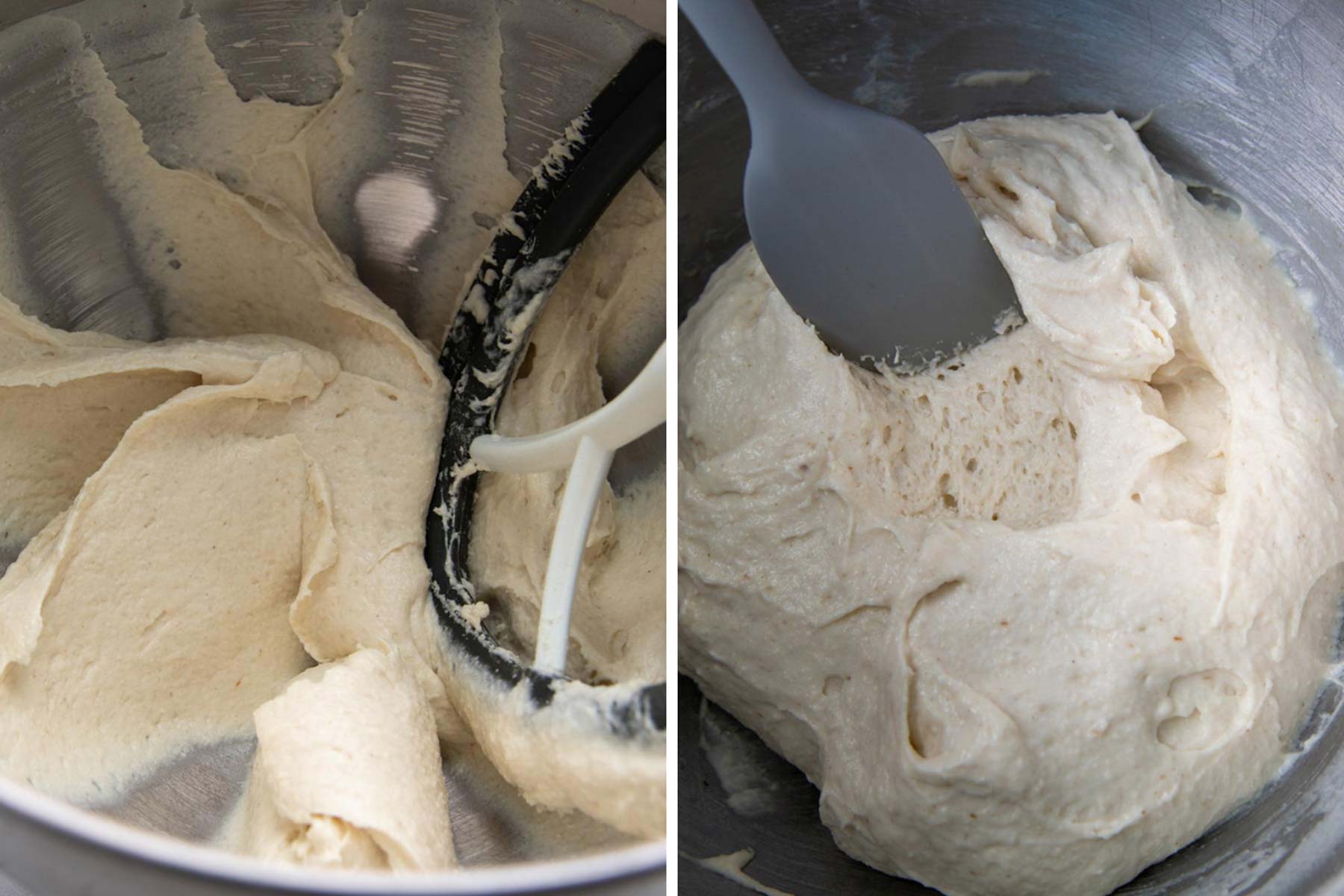
- In the large mixing bowl of a stand mixer, use a paddle attachment to combine the dry ingredients – gluten-free flour, almond flour, psyllium husk powder, baking powder, salt, and yeast.
- Continue mixing and slowly pour in warm water and oil to activate the yeast mixture. Mix until combined and then increase the speed to medium-high and beat for 5 minutes. The dough will be a sticky batter.
- Scrape the dough into the center of the bowl. Cover with plastic wrap and let rise in a draft-free place for 90 minutes. When using a spoon to look inside the dough, it should be bubbly.
Now that the dough is ready, it’s time to shape and bake the crust for your pizza base. After the crust bakes it may be used immediately, stand for several hours, or freeze for later use.
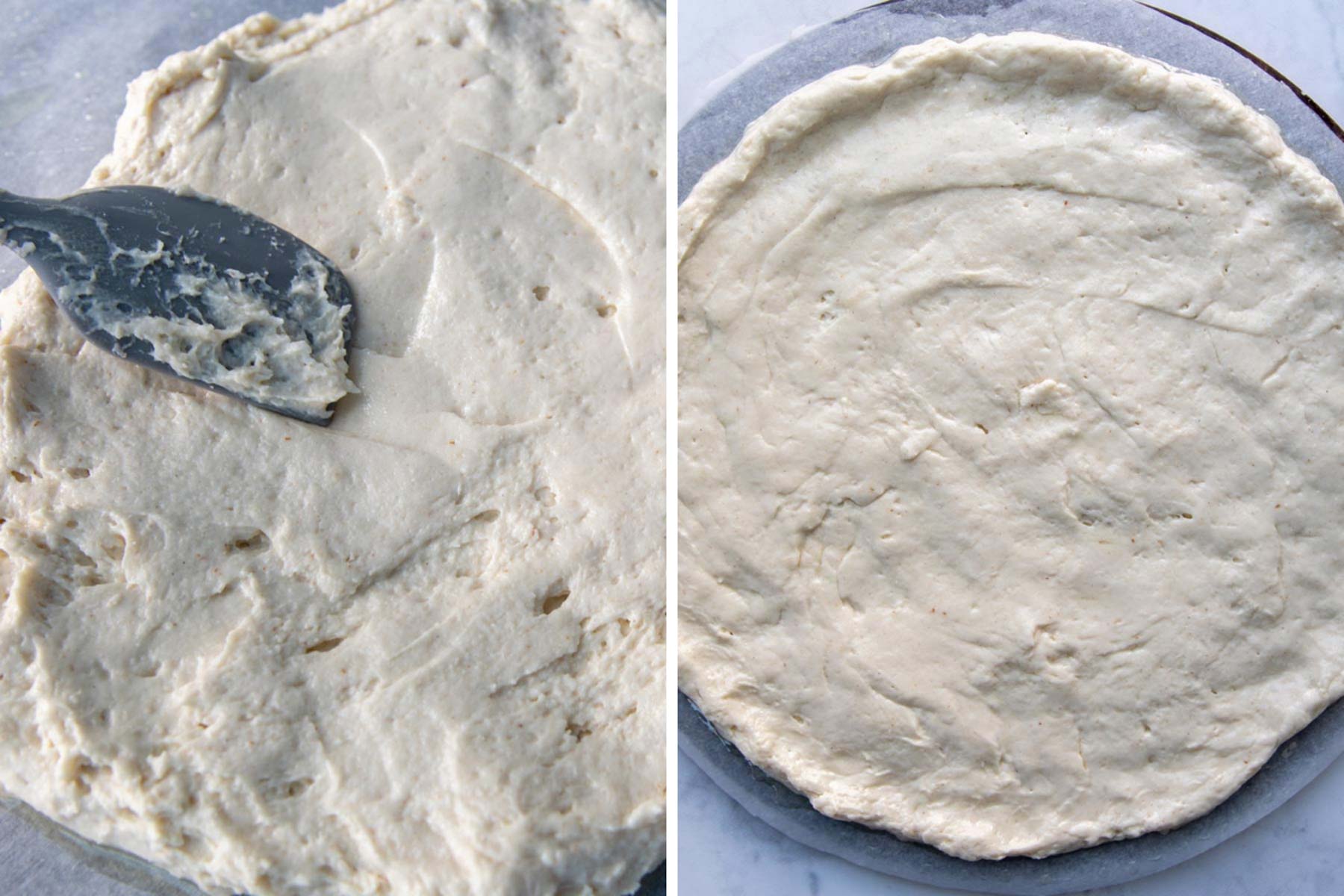
- Preheat oven to 325°F. Line a pizza stone with a piece of parchment paper. If you do not have a pizza stone, line a large baking sheet with parchment. Spray the paper with cooking spray to grease.
- Transfer the dough into the center of the prepared pan. Use a greased silicone spoon to spread the dough into a circle. Continue greasing the spoon to spread out into a 11 ½” circle.
- Bake for 45-50 minutes, or until the dough is firm to the touch and slightly starts to brown underneath.
- When ready to make your gluten-free pizza, place the stone in the oven and preheat to 500°F. Transfer the parbaked crust to pizza peel for an easy transfer to the hot stone.
- Spread on pizza sauce, cheese, and toppings. Slide the pizza onto the hot stone using the pizza peel. Bake for 8-10 minutes, or until the crust is golden brown and the cheese bubbles. Alternatively, check out how to make gluten-free pizza on the grill!
Recommended gluten-free flour
The success of this recipe really depends on a high-quality all purpose gluten-free flour. I use and recommend Cup4Cup because the taste and texture best replicates gluten-full versions. However, it does contain milk powder.
If you need a gluten-free dairy-free pizza crust, use King Arthur Measure-for-Measure. I don’t suggest Bob’s Red Mill because of the off-putting, strong taste from brown rice flour and sorghum flour.
recommended equipment and alternatives
To achieve a golden, crispy crust with a soft layer above for toppings, I highly recommend using a pizza stone. I like this particular pizza stone because it’s circular, which serves as a guide for dough shaping, and has handles for lifting.
The stone heats in the high-temperature oven to become extremely hot before placing on the assembled pizza. This gives a jump start for making a crispy crust with the short baking time required for the toppings and cheese.
To assemble the pizza and move onto the hot pizza stone, I recommend using a pizza paddle or peel. Otherwise it’s tricky to transfer the unbaked pizza to the oven without disturbing the toppings or burning yourself!
If you do not have a stone, preheat a baking sheet or pizza pan in the oven. While it won’t make as crisp as a crust, it’s better than using a cold pan. A rimless baking sheet would also work instead of using a pizza paddle to slide it on.
If you are wondering if this dough could be used to make calzones, see this easy homemade gluten-free calzone recipe and follow the baking tips!
freezing and storing
Although homemade gluten-free pizza crust does take some time on the front end for rising and baking, it is freezer-friendly and may be baked right from frozen!
It’s also a good idea to double the recipe, making two crusts at once. Then freeze one for a quick and easy Friday pizza night!
To freeze, cool completely, wrap securely in plastic, and then cover with aluminum foil. Freeze up to 3 weeks. When ready to bake, assemble and bake from frozen.
To store, let it sit at room temperature for 4 hours after the initial bake, or wrap securely in plastic.
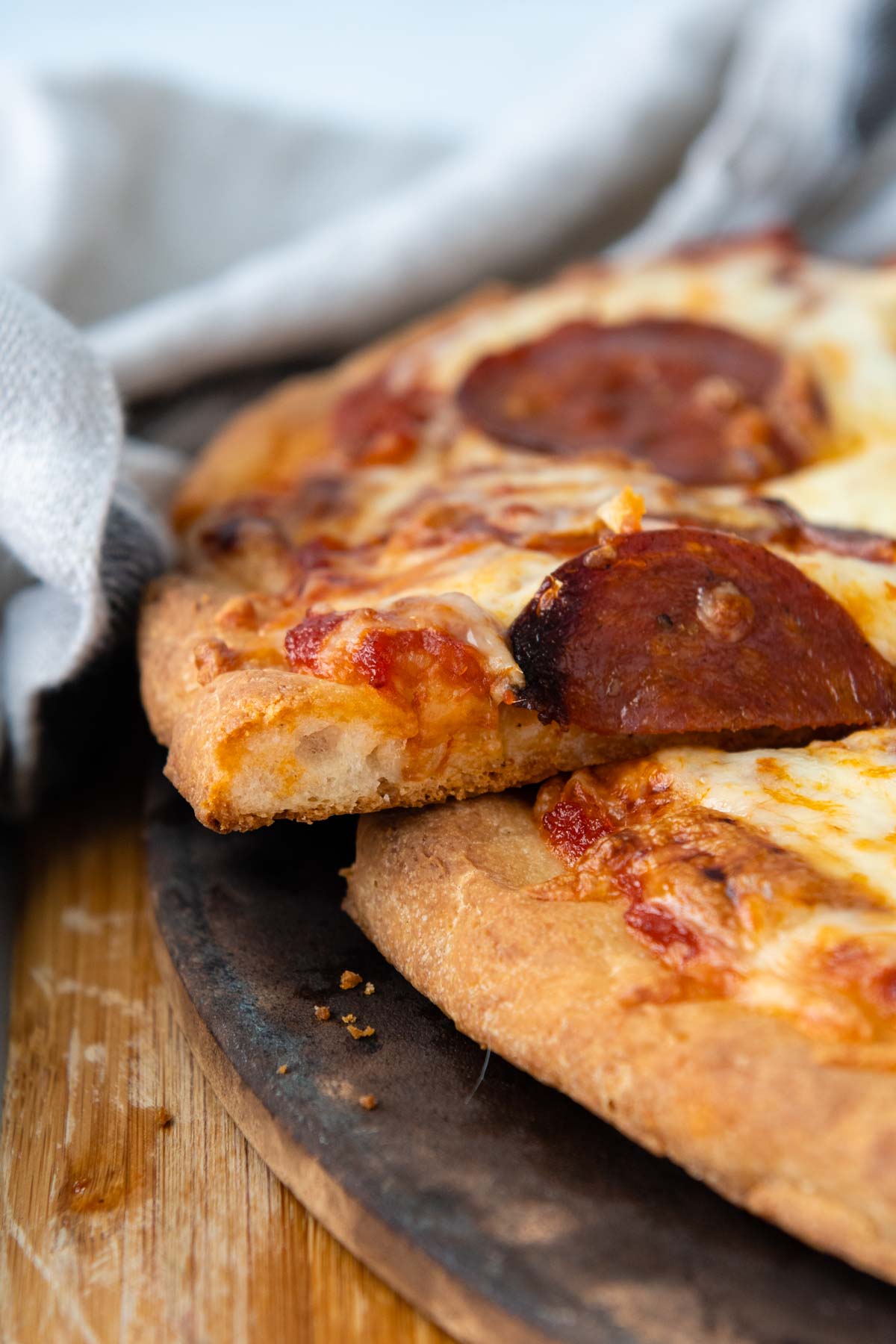
Expert tips and tricks
- The gluten-free pizza crust texture and ease is helped by some essential pizza-making equipment. Using a pizza stone achieves a crispy crust, while a pizza paddle makes for a flawless transfer to the hot oven.
- When shaping the pizza dough, be sure it is spread out to at least a 11 ½” circle. Using a baking sheet limits the diameter, making a thicker crust. Therefore, a round stone (best) or pizza pan is recommended.
- Since the crust is parbaked, it could be used for grilled pizza as well!
- The dough is easy to work with as long as it is liberally greased. Keep nonstick cooking spray or a pastry brush and olive oil handy when shaping.
- Double the recipe to make one crust for now, and freeze the other for a quick, easy pizza night. It may be assembled and baked from frozen.
Does the dough need to rise twice?
No, this recipe only requires one rise. Traditional doughs use a second rise to give yeast more time to work and change the gluten structure for a lighter, chewier texture. Since there is no gluten, and rise is aided with baking powder, there is no need to let the dough rise twice.
Make-ahead tips
If assembling and baking the pizza crust later, move to a wire rack to cool completely. At this point it may sit at room temperature for 4 hours or wrap securely in plastic, cover with aluminum foil, and freeze up to 3 weeks. When ready to bake, assemble and bake from frozen.
Making crust extra crispy
To make gluten-free pizza crispy use a pizza stone. It heats in the high-temperature oven to become extremely hot before placing on the assembled pizza. This gives a jump start for making a crispy crust with the short baking time required for the toppings and cheese.
Dairy-free / vegan modifications
No adaptations are needed for a dairy-free or vegan pizza crust. However, read the ingredient label on your gluten-free flour. Recommended Cup4Cup adds milk powder to its blend, so instead use Ancient Grains Cup4Cup or King Arthur Measure-for-Measure
Click here to see the
step-by-step web story instructions for this recipe!
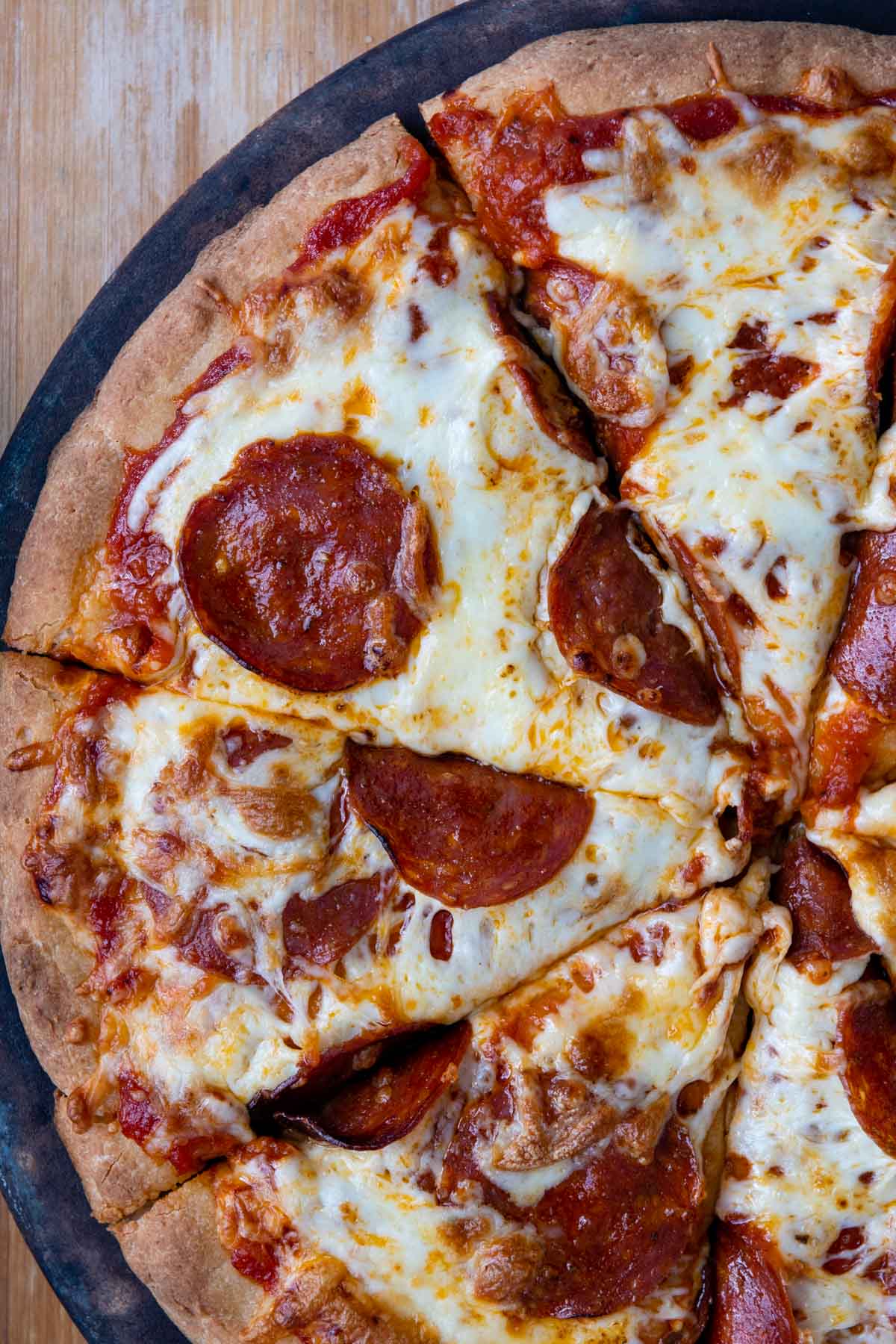
SAVE THIS recipe homemade gluten-free pizza crust for TO YOUR PINTEREST BOARD!
Let’s be friends on Pinterest! I’m always sharing great recipes!
Easy Pizza Crust With Gluten-Free Flour
Listen to Recipe Audio
Equipment Needed
Ingredients
- 1 ⅔ cup (233 g) gluten-free all purpose flour
- ¼ cup (23 g) almond flour (for best results, but may also sub additional GF flour or oat flour)
- 2 teaspoons (8 g) psyllium husk powder (what is psyllium husk?)
- 1 ¼ teaspoon baking powder
- 1 teaspoon salt
- ½ teaspoon instant yeast
- 1 ¼ cup (300 g) warm water
- 2 tablespoons (27 g) olive oil
Instructions
- In the large mixing bowl of a stand mixer, use a paddle attachment to combine on low speed gluten-free flour, almond flour (or additional flour), psyllium husk powder, baking powder, salt, and yeast.1 ⅔ cup (233 g) gluten-free all purpose flour,¼ cup (23 g) almond flour,2 teaspoons (8 g) psyllium husk powder,1 ¼ teaspoon baking powder,1 teaspoon salt,½ teaspoon instant yeast
- Continue mixing on low speed and slowly pour in water and oil. Mix until combined. Increase the speed to medium-high and beat for 5 minutes. The dough will be a sticky batter.1 ¼ cup (300 g) warm water,2 tablespoons (27 g) olive oil
- Use a rubber spatula to scrape all the dough into the center of the bowl. Cover securely with plastic wrap and let rise in a draft-free place for 90 minutes. When using a spoon to look inside the dough, it should be bubbly.
- Preheat oven to 325°F. Line a pizza stone with parchment paper. If you do not have a pizza stone, line a large baking sheet with parchment. Spray the paper with cooking spray to grease.
- Transfer the dough into the center of the prepared stone or pan. Use a liberally greased silicone spoon to spread the dough into a circle. Continue greasing the spoon, or the top of the pizza dough, to spread out into a 11 ½" circle. If desired, use greased fingers to shape the edges into a raised crust.
- Bake for 45-50 minutes, or until the dough is firm to the touch and slightly starts to brown underneath.
- If assembling and baking the pizza crust later, move to a wire rack to cool completely. At this point it may sit at room temperature for 4 hours or wrap securely in plastic, cover with aluminum foil, and freeze up to 3 weeks. When ready to bake, assemble and bake from frozen.
- When ready to make the pizza, place the pizza stone in the oven and then preheat to 500°F. (See recipe notes if you do not have a pizza stone.) Transfer the parbaked crust to pizza peel for an easy transfer to the hot stone.
- Spread on pizza sauce, cheese, and toppings. Slide the pizza onto the hot stone using the pizza peel. Bake for 8-10 minutes, or until the crust has browned and the cheese is bubbly.
- Did you make this recipe? Don't forget to click star rating on recipe card and leave a comment below!
Recipe Notes
Making without pizza stone
If you do not have a stone, preheat a baking sheet or pizza pan in the oven. While it won’t make as crisp as a crust, it’s better than using a cold pan. A rimless baking sheet would also work instead of using a pizza paddle to slide it on.freezing and storing
Although this gluten-free pizza crust recipe does take some time on the front end for rising and baking, it is freezer-friendly and may be baked right from frozen! It’s also a good idea to double the recipe, making two crusts at once. Then freeze one for a quick and easy Friday pizza night! To freeze, cool completely, wrap securely in plastic, and then cover with aluminum foil. Freeze up to 3 weeks. When ready to bake, assemble and bake from frozen. To store, let it sit at room temperature for 4 hours after the initial bake, or wrap securely in plastic.expert tips and tricks
- The gluten-free pizza crust texture and ease is helped by some essential pizza-making equipment. Using a pizza stone achieves a crispy crust, while a pizza paddle makes for a flawless transfer to the hot oven.
- When shaping the pizza dough, be sure it is spread out to at least a 11 ½” circle. Using a baking sheet limits the diameter, making a thicker crust. Therefore, a round stone (best) or pizza pan is recommended.
- Since the crust is parbaked, it could be used for grilled pizza as well!
- The dough is easy to work with as long as it is liberally greased. Keep nonstick cooking spray or a pastry brush and olive oil handy when shaping.
- Double the recipe to make one crust for now, and freeze the other for a quick, easy pizza night. It may be assembled and baked from frozen.
Nutrition
This post contains affiliate links. My opinions are always my own. If you purchase a product through an affiliate link, I make a small commission – at no cost to you. Read full disclosure policy here.



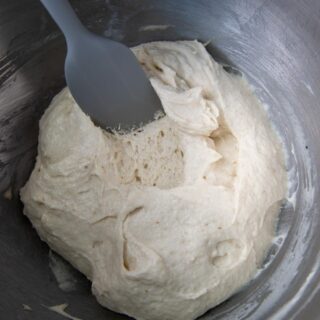
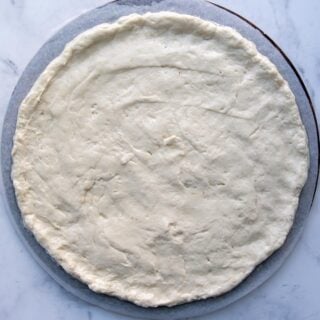
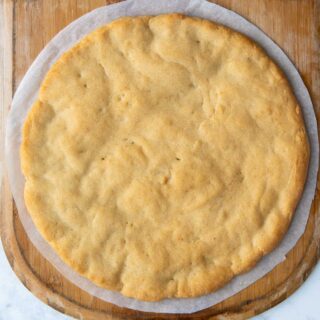
Christine says
We had pizza night tonight. My husband made his usual two pizzas and my daughter and fellow Celiac were going to eat store bought GF pizza. I remembered this pizza recipe and I have it the jackpot. I liked that it only made one crust, its an easy recipe to make as I need it. The instructions on par baking were clear which has been a problem with other recipe I’ve tried, the baked pizza was crisp and could handle all the toppings I put on. My daughter and I ate the whole pizza, it was so delicious. Thank you.
Melissa Erdelac says
Thank you so much, Christine. Eating a good GF pizza is a well deserved win for us after all the subpar substitutes. Sometimes when I make it I double the recipe and freeze one (after parbaking) so it’s an even quicker treat next time we have pizza night.
Best,
Melissa
Louise says
forgot the rating
Louise says
really good
the best we have tried yet
thanks for the recipe
Melissa Erdelac says
Appreciate it so much! Thanks for taking the time to write, Louise!
Best,
Melissa
NYNonna says
Thank you, Melissa, for another great gluten free recipe. We just finished eating this delicious crispy pizza for dinner and loved it. It was easy to make following your directions. For some reason it takes longer for my breads and dough to rise than the prescribed time but that isn’t a problem at all. Worth the wait!
Melissa Erdelac says
Thank you so much! I’m so happy you are enjoying the recipes, particularly this one! A great GF pizza crust was something I found hard to come by and I feel like this one doesn’t disappoint! I usually raise things in my oven with a “proof” setting, so it’s a little warmer than just sitting in a kitchen.
Best,
Melissa
Lori says
Hi, I would love to give this recipe a try but I don’t eat grains. So could I use 1 2/3 of almond flour and 1/4 coconut flour?
Melissa Erdelac says
Hi Lori,
Not with this recipe, but I just published an almond flour pizza crust recipe that would work for!
Best,
Melissa
Cheryl Thomas says
This was so easy to make and so delicious! Thank you for a great recipe that even my non-GF husband loved!
Melissa Erdelac says
Yay! Love this, Cheryl! Thank you so much for letting me know!
Best,
Melissa
Jeriann Hughes/Marks says
I am so grateful for the notes on Pizza crust. Thank you for sharing this recipe.
Melissa says
You’re so welcome! Enjoy, Jeriann!
Best,
Melissa